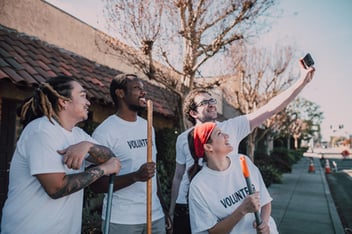There are lots of ways volunteers can help your organization deliver on its mission. From direct service volunteering to pro bono work, volunteer leaders need to understand the different types of volunteer work roles in order to recruit the best volunteer for the job.
In this article, we’ll learn about the types of volunteering and how to promote these volunteer roles and responsibilities.
Let’s get started!
What Are the Different Types of Volunteering?
There are many ways a volunteer can support your organization. When starting your volunteer program, you’ll want to consider your community’s needs and how volunteers can help address these needs.
Here are a few factors to consider when designing your volunteer roles:
- Level and Length of Commitment - Are you asking volunteers to commit to a one-time event or weekly? You’ll want to align volunteer expectations with your organization’s needs.
- Direct Service vs. Indirect Service - Are your volunteers working directly with clients and community members or behind the scenes? Indirect service roles are equally essential to supporting volunteer programs and can range from administrative work to community activism.
- Volunteer Experience and Skill Level - Will your volunteer roles require specialized skills, qualifications, or professional-level experience? Can students support your program goals, for example?
Regardless of the types of volunteers you engage, most organizations benefit from a structured volunteer program. A volunteer program is an organized way of managing your volunteers, from recruitment to volunteer appreciation.
Volunteers can take on many roles, including:
Direct Service Volunteering
Direct service is one of the most common types of volunteering and is part of a supervised volunteer program.
Direct service volunteers work directly with community members in community development initiatives. Community development volunteers work together towards a common goal of building stronger communities.
These types of volunteer work roles can be wide-ranging, from disaster response to beautifying community spaces.
How can your community benefit from direct volunteer services? Here are some examples of direct service volunteer roles:
- Collecting, distributing, cooking, or serving meals
- Sorting food bank donations
- Tour guide or docent
- Working with shelter animals
- Supporting homeless shelters and their clients
- Leading after-school programs for children
Indirect Service Volunteering
Volunteers can support your organization in so many ways beyond direct service. Volunteers make great leaders, fundraisers, advocates for your cause, and more.
By thinking outside the box, you can learn to leverage volunteers of all kinds to advance your mission. Let’s take a look at some types of indirect service volunteering:
Organizational Support and Leadership
Volunteers can work behind the scenes to support the day-to-day operations of the organizations they serve. From leadership opportunities to administrative support, these types of volunteers don’t work directly with clients, but can be vital to the success of your organization.
Examples of this type of volunteer work include:
- Social media account management
- PTA Treasurer
- Member of the Board of Directors
- Data entry
- Volunteer leaders
Fundraising and Philanthropy
Fundraising is a critical function of most social impact organizations. Did you know that volunteers can support your funding efforts?
Fundraising volunteer opportunities can include:
- Plan fundraising events and campaigns
- Collect donated goods or funds
- Fundraise by reaching out to individual citizens or companies
- Donate to an organization directly
Community Activism
Community organizers and activists use their voices and connections to raise awareness of key community issues and inspire action.
These kinds of volunteers might be responsible for educating the public on an issue, coordinating marches, or influencing policymakers.
Social Action Volunteering
Social action volunteering is driven by a common advocacy goal. Some examples of social volunteering work include:
- Campaigning for a sustainable environment
- Lobbying for political groups
- Working with children and youth
Event Volunteering
Organizing and running an event requires lots of helping hands. Why not enlist the help of volunteers? Volunteers are great resources for supporting your next event at any stage, whether it’s a fundraising gala or performance.
Here are some examples of event volunteer roles:
- Ushers and ticketing
- Event set-up and take-down
- Event promotion and registration
To recruit and manage event volunteers, you’ll need to have efficient management and communications tools established. Event management software can help you host fundraisers, schedule volunteers, and communicate with attendees easily.
Skilled or Pro Bono Volunteering
Pro bono is professional or skilled work donated to those in need. While pro bono often involves legal services, the term can also refer to any professional work provided without charge.
Some common examples of pro bono volunteer work include:
- Legal advice and services
- Tax preparation
- Free physician visits or medical services
- Professional mentorship
This type of work is highly structured and usually requires a more extensive recruitment and vetting process. Learn more about how your organization can leverage pro bono and skilled volunteers.
Virtual Volunteering
Virtual volunteering is any volunteer activity that can be done online or at home. Like traditional volunteer programs, intentional virtual volunteer recruitment and management leads to greater impact.
Some common types of virtual volunteer roles include:
- Data Entry (or other administrative tasks)
- Teen Mentoring
- Graphic Design
- Editing and Writing
- Document Translation
- Research
- Virtual Senior Companionship
- Knitting
- Phone-Based Fundraising
- Virtual Tutoring
Microvolunteering
Microvolunteering is a type of volunteering that allows people to volunteer quickly and conveniently. If your volunteers have a minute or an hour, they can support meaningful social impact initiatives.
Here are some examples of microvolunteering activities:
- Share a post on social media to raise awareness or ask for donations
- Sign a petition
- Donate supplies or collect donations
- Fill out a survey
- Translate a document
- Record a video
- Donate skills, such as graphic design
- Tend a community garden or pick up trash
Learn how your organization can engage microvolunteers.
Community Service
Community service is similar to volunteering in that it is unpaid work performed by a person or group of people for the benefit of the community. Community service can be different from volunteering because it is not always performed on a voluntary basis.
While some community service roles may be similar to the roles of volunteers, the reasons a person might partake in community service can differ.
Here are some reasons a person might participate in community service:
- To fulfill a court-ordered mandate
- To receive academic scholarships or requirement
- To enhance one’s academic experience
- To become a member of an organization, such as a religious institution
Community service is often organized by an organization, such as a school, place of worship, or government agency.
Service Learning
Service learning is a type of volunteering or community service managed by schools, colleges, and universities.
Students of all ages can participate in service learning volunteerism. Service learning connects experiential learning with community service or volunteerism so that students can engage in hands-on activities that support their in-classroom learning while addressing community needs.
Some examples of service learning projects include:
- Planting and Maintaining Vegetable or Pollinator Gardens
- Cleaning Up Beaches
- Creating Awareness Campaigns
- Citizen Science Projects
- Nonprofit Internships
Employee Volunteerism and Corporate Social Responsibility
Corporate volunteerism is workplace-supported volunteering that connects employees with community-based organizations and their volunteering opportunities.
Employee volunteerism is usually part of a company’s corporate social responsibility initiative. Businesses typically partner with local social impact organizations and nonprofits to create volunteer opportunities that benefit all parties.
From single-day events to regular opportunities throughout the year, corporate volunteers can offer time, skills, and resources that help move your mission forward.
Check out these examples of corporate volunteer programs and projects.
Informal Volunteering
Informal volunteer work is usually unfunded and unstructured by a volunteer program. Informal volunteer work includes voluntary acts of kindness, such as buying food for a person in need or helping a neighbor with yard work.
Other examples of volunteer work include:
- Street clean up
- Neighborhood safety patrol
- Community garden tending
- Delivering meals to friends and neighbors
- Mentoring a young professional
- Helping others with household chores
- Mailing letters to hospitalized children
These acts of service occur daily in nearly every community around the world and often go unrecognized. However, it’s important to understand the impact of everyday acts of service in helping to shape our communities.
What Are Some Examples of Volunteer Opportunities?
Need more volunteering examples? Here are some volunteer roles and opportunities to inspire your next initiative:
- Virtual Storytime Readers
- Social Media Account Management
- Local Library Volunteer
- Animal Shelter Volunteer
- Field Trip Chaperone
- ESL Tutoring
- Meal Delivery
- Gathering Donated Supplies
However your volunteers get involved, you’ll need to write compelling volunteer opportunity listings that convert!
How to Promote Various Volunteer Opportunities
Effective volunteer management helps nonprofits recruit, track, engage and retain a significant number of volunteers. The following are some of the tips on how volunteer managers can get more volunteers involved:
- Write Specific Volunteer Opportunity Descriptions: Your volunteer recruitment copy should inspire more prospects to get involved in your cause. Therefore, it’s essential that volunteer requirements are detailed and expectations are managed so that volunteers can self-select the opportunities that align with their passions and skills.
- Use a Variety of Recruitment Channels: Once you have the right messaging for your volunteers, diversify your recruitment channels and repurpose your call to action to fit the different channels. Some of the most productive channels to consider are volunteer recruitment software, Google Ads, social media recruitment, and community partnerships.
- Asses and Train Volunteers: Part of your onboarding process involves conducting a general evaluation to understand the skill sets that each volunteer offers your campaign. This will help you assign the right talent to the volunteer activity. What’s more, understanding your volunteer aptitudes can help you provide specialized training and allocate your resources effectively.
- Create Communication Channels: You should also create robust two-way communication between you and your volunteers. Strong communication fosters stronger connections and relationships. This step is especially crucial if your volunteers are helping you remotely.
How to Leverage the Volunteer Management Software to Optimize Your Volunteer Program
Volunteering offers several benefits to both the organization and individual volunteers.
Volunteer programs help promote positive and sustainable growth within communities. It is also an effective way to enhance social connections and improve employability for volunteers.
Volunteer management involves creating robust plans for recruitment, training, and coordinating various volunteers.
Leveraging the best volunteer management software can help you optimize operational progress to achieve the desired objectives.
Get Connected provides top-notch volunteer management software that helps organizations plan, recruit, and manage volunteers in a single platform.





